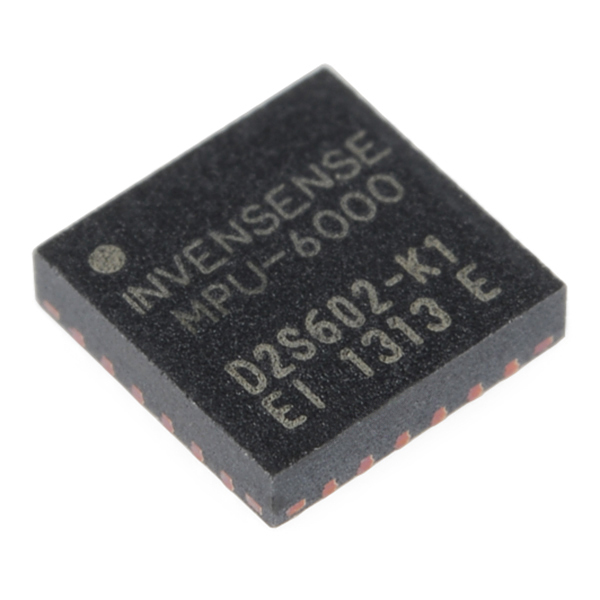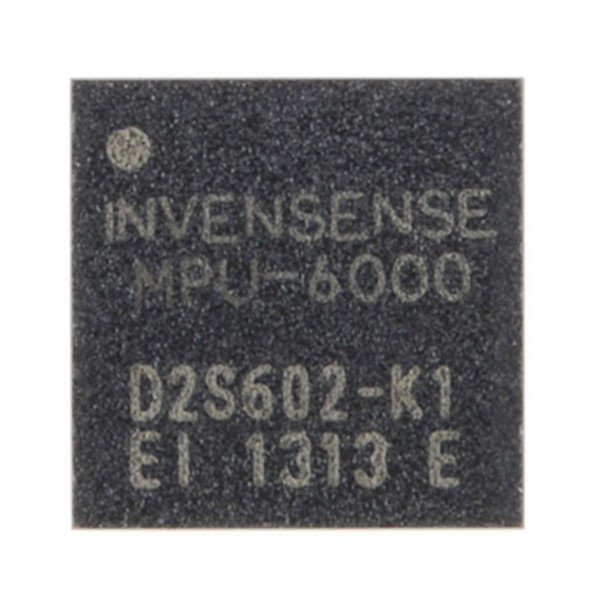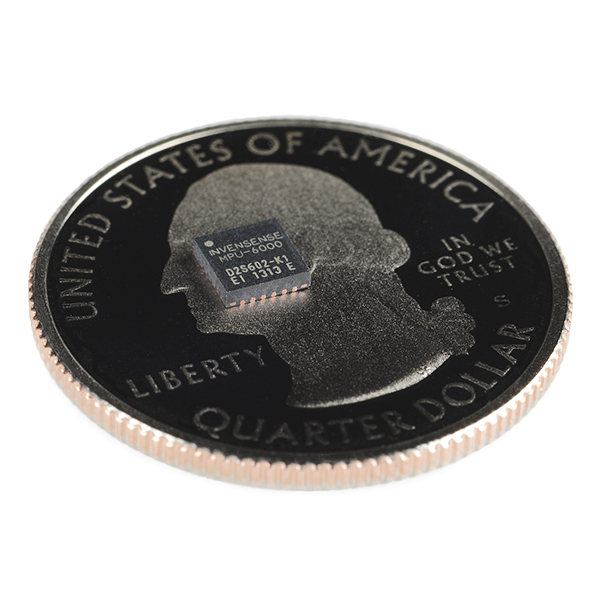MPU-6000 - Motion Processing Unit
The MPU-6000 is a serious little piece of motion processing tech! By combining a MEMS 3-axis gyroscope and a 3-axis accelerometer on the same silicon die together with an onboard Digital Motion Processor™ (DMP™) capable of processing complex 9-axis MotionFusion algorithms, the MPU-6000 does away with the cross-axis alignment problems that can creep up on discrete parts. The parts’ integrated 9-axis MotionFusion algorithms can even access external magnetometers or other sensors through an auxiliary master I2C or SPI bus, allowing the devices to gather a full set of sensor data without intervention from the system processor.
Communication with all registers of the device is performed using either I2C at 400kHz or SPI at 1MHz. For applications requiring faster communications, the sensor and interrupt registers may be read using SPI at 20MHz.
- Digital-output of 6 or 9-axis MotionFusion data in rotation matrix, quaternion, Euler Angle, or raw data format
- Tri-Axis angular rate sensor (gyro) with a sensitivity up to 131 LSBs/dps and a full-scale range of ±250, ±500, ±1000, and ±2000dps
- Tri-Axis accelerometer with a programmable full scale range of ±2g, ±4g, ±8g and ±16g
- 20MHz SPI serial interface for reading sensor and interrupt registers
- Reduced settling effects and sensor drift by elimination of board-level cross-axis alignment errors between accelerometers and gyroscopes
- Digital Motion Processing™ (DMP™) engine offloads complex MotionFusion, sensor timing synchronization and gesture detection
- Embedded algorithms for run-time bias and compass calibration. No user intervention required
- Digital-output temperature sensor
- Digital input on FSYNC pin to support video Electronic Image Stabilization and GPS
- Programmable interrupt supports gesture recognition, panning, zooming, scrolling, free fall interrupt, high-G interrupt, zero-motion detection, tap detection, and shake detection
- VDD Supply voltage range of 2.375V–3.46V
- On-chip timing generator with ±1% frequency variation over full temperature range
- 10,000g shock tolerant
- 4x4x0.9mm QFN
- [Datasheet](http://cdn.sparkfun.com/datasheets/Components/General IC/PS-MPU-6000A.pdf)
MPU-6000 - Motion Processing Unit Product Help and Resources
Core Skill: Soldering
This skill defines how difficult the soldering is on a particular product. It might be a couple simple solder joints, or require special reflow tools.
Skill Level: Competent - You will encounter surface mount components and basic SMD soldering techniques are required.
See all skill levels
Core Skill: Programming
If a board needs code or communicates somehow, you're going to need to know how to program or interface with it. The programming skill is all about communication and code.
Skill Level: Competent - The toolchain for programming is a bit more complex and will examples may not be explicitly provided for you. You will be required to have a fundamental knowledge of programming and be required to provide your own code. You may need to modify existing libraries or code to work with your specific hardware. Sensor and hardware interfaces will be SPI or I2C.
See all skill levels
Core Skill: Electrical Prototyping
If it requires power, you need to know how much, what all the pins do, and how to hook it up. You may need to reference datasheets, schematics, and know the ins and outs of electronics.
Skill Level: Competent - You will be required to reference a datasheet or schematic to know how to use a component. Your knowledge of a datasheet will only require basic features like power requirements, pinouts, or communications type. Also, you may need a power supply that?s greater than 12V or more than 1A worth of current.
See all skill levels
Comments
Looking for answers to technical questions?
We welcome your comments and suggestions below. However, if you are looking for solutions to technical questions please see our Technical Assistance page.
Customer Reviews
No reviews yet.





Would be nice to be able to use the mentioned gesture recognition, but where to start? The manual just says it is possible, but not how. Apparently the company will not share their knowledge, so, how and where to start?
I found quite a bit of documentation at: http://www.invensense.com/mems/gyro/mpu6050.html. By registering, http://www.invensense.com/developers/index.php?_r=default, it seems that access to the motion processor info is available. Unfortunately I can't access my email - it is on a different computer which I can't get to without disconnecting my work box - my KVM switch died and the new one has not arrived yet. I'll have to wait until after work to see what the registration allows me to do.
Stupid question, what's the Eagle part named? I can't seem to find it.
It's MPU-6000, but you need to download the SparkFun eagle library from github
I really would like to have this chip with the SPI bus broken out, do anyone know where I can locate one please? Thank you.
Tell me that it's already on a breakout, with all optional auxiliary components (magnetometer, etc...) in a tight package ready to go!?
We are working on getting this into a breakout board, so keep your eyes on the new product page in about a month or two.
Too bad it's going to take that long. I'd be interested in making my own, but the overhead of SMD is kinda heavy. What is the difference between this MPU6050.
The New Product Friday post from 2013/May/24 happened to mention:
Nope. What you see is what you guy (Minus the quarter). The MPU series really is amazing for the price though. Just wish I'd see a nice board with them and a magnetometer for ~$30. Also that the company would release info on the MotionFusion bit so we don't have to rely on reverse engineering control of it. It's absurd that a company sells a product but refuses to give you the datasheets that actually you know, make it essentially unique and awesome, unless you're a company...
I agree, if we could get the MotionFusion documentation for this it would be great. I've played with one of these using the FreeIMU libraries vs the reverse engineered MotionFusion and the on-chip stuff does quite a bit better job.
If you want a board that combines multiple sensors for relatively cheap, take a look at MultiWii-compatible flight controllers (like this or this). They're basically just Ardruinos with one or two sensor chips sitting on the I2C bus.